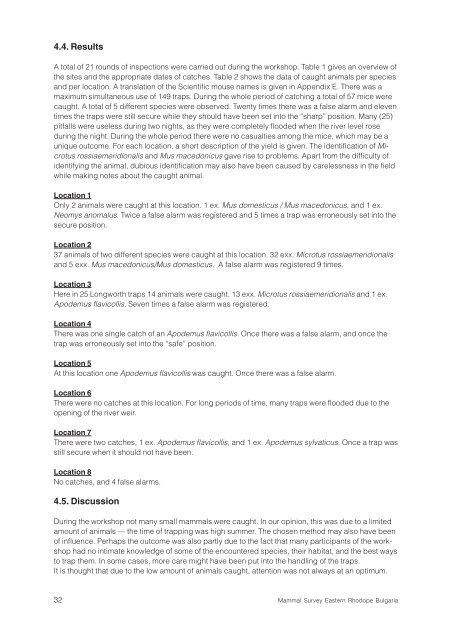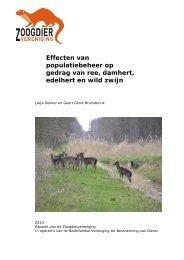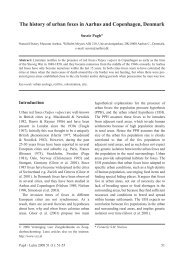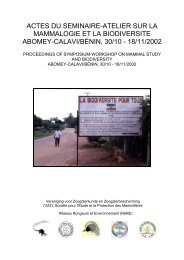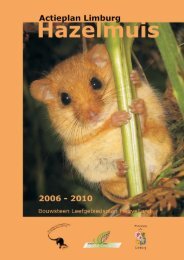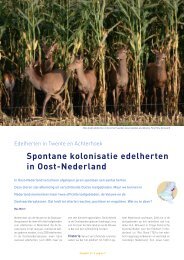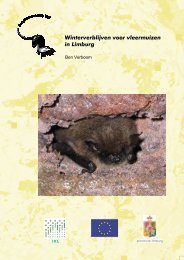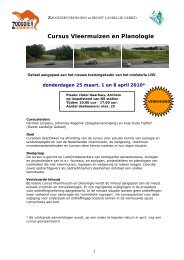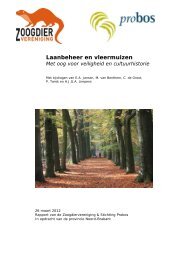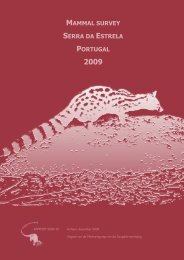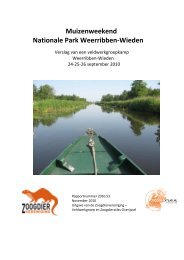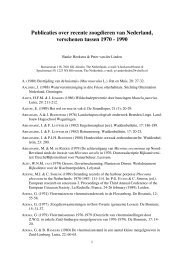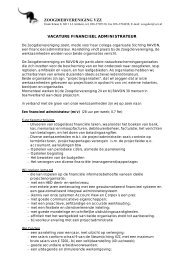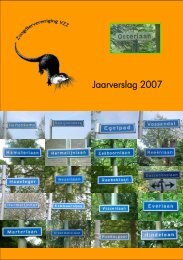Mammal Survey Eastern Rhodopes Bulgaria - De Zoogdiervereniging
Mammal Survey Eastern Rhodopes Bulgaria - De Zoogdiervereniging
Mammal Survey Eastern Rhodopes Bulgaria - De Zoogdiervereniging
- No tags were found...
Create successful ePaper yourself
Turn your PDF publications into a flip-book with our unique Google optimized e-Paper software.
4.4. ResultsA total of 21 rounds of inspections were carried out during the workshop. Table 1 gives an overview ofthe sites and the appropriate dates of catches. Table 2 shows the data of caught animals per speciesand per location. A translation of the Scientific mouse names is given in Appendix E. There was amaximum simultaneous use of 149 traps. During the whole period of catching a total of 57 mice werecaught. A total of 5 different species were observed. Twenty times there was a false alarm and eleventimes the traps were still secure while they should have been set into the “sharp” position. Many (25)pitfalls were useless during two nights, as they were completely flooded when the river level roseduring the night. During the whole period there were no casualties among the mice, which may be aunique outcome. For each location, a short description of the yield is given. The identification of Microtusrossiaemeridionalis and Mus macedonicus gave rise to problems. Apart from the difficulty ofidentifying the animal, dubious identification may also have been caused by carelessness in the fieldwhile making notes about the caught animal.Location 1Only 2 animals were caught at this location. 1 ex. Mus domesticus / Mus macedonicus, and 1 ex.Neomys anomalus. Twice a false alarm was registered and 5 times a trap was erroneously set into thesecure position.Location 237 animals of two different species were caught at this location. 32 exx. Microtus rossiaemeridionalisand 5 exx. Mus macedonicus/Mus domesticus. A false alarm was registered 9 times.Location 3Here in 25 Longworth traps 14 animals were caught. 13 exx. Microtus rossiaemeridionalis and 1 ex.Apodemus flavicollis. Seven times a false alarm was registered.Location 4There was one single catch of an Apodemus flavicollis. Once there was a false alarm, and once thetrap was erroneously set into the “safe” position.Location 5At this location one Apodemus flavicollis was caught. Once there was a false alarm.Location 6There were no catches at this location. For long periods of time, many traps were flooded due to theopening of the river weir.Location 7There were two catches, 1 ex. Apodemus flavicollis, and 1 ex. Apodemus sylvaticus. Once a trap wasstill secure when it should not have been.Location 8No catches, and 4 false alarms.4.5. DiscussionDuring the workshop not many small mammals were caught. In our opinion, this was due to a limitedamount of animals — the time of trapping was high summer. The chosen method may also have beenof influence. Perhaps the outcome was also partly due to the fact that many participants of the workshophad no intimate knowledge of some of the encountered species, their habitat, and the best waysto trap them. In some cases, more care might have been put into the handling of the traps.It is thought that due to the low amount of animals caught, attention was not always at an optimum.32 <strong>Mammal</strong> <strong>Survey</strong> <strong>Eastern</strong> Rhodope <strong>Bulgaria</strong>


